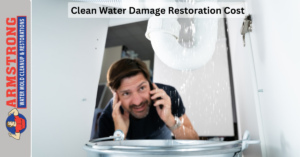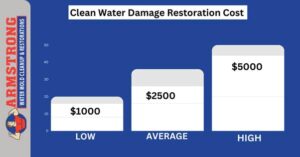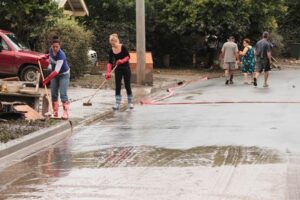
Is clean water damage restoration as affordable as it sounds? Let’s break it down.
Cost breakdown of Clean Water Damage Restoration
| Cost Category | Price Range |
| Low Cost | $1,000 |
| Average Cost | $2,500 |
| High Cost | $4,000 |

How to clean water damage restoration costs stack up—what you need to know.
| Type of Clean Water Damage | Average Mitigation Cost | Factors Affecting Cost |
| Broken or Leaking Pipes | $150 – $2,500 | Size of the leak, location of the pipe, and whether drywall, flooring, or ceilings are damaged. |
| Overflowing Sinks or Tubs | $200 – $1,500 | The extent of overflow, type of flooring or cabinetry affected, and duration before cleanup. |
| Appliance Malfunctions | $300 – $3,000 | Type of appliance, amount of water released, and damage to nearby structures. |
| Rainwater or Melting Snow Intrusion | $500 – $5,000 | The severity of the roof leak or window damage, size of the affected area, and insulation replacement costs. |
| Burst Water Heater or Tank | $500 – $2,500 | Size of the water heater, extent of flooding, and damage to surrounding structures. |
| Sprinkler System Discharges | $1,000 – $4,000 | Number of sprinklers activated, area affected, and damage to furniture or electronics. |
| Condensation or HVAC Leaks | $150 – $1,000 | Regular HVAC maintenance costs vs. extensive water damage repair if left unaddressed. |
Introduction
Understanding the clean water damage restoration cost in Fort Myers, FL is crucial when dealing with unexpected disasters. The clean water damage restoration price typically depends on the extent of damage, services required, and local rates. From minor fixes to major overhauls, the cost of clean water damage restoration in Fort Myers can vary significantly. Avoid unnecessary clean water damage restoration expenses by knowing what’s included and planning for a smoother recovery process.
Types of Clean Water Damage Restoration
Broken or Leaking Pipes
Broken or leaking pipes are a common cause of clean water damage, often due to aging plumbing systems, freezing temperatures, or high water pressure. These leaks can result in water seeping into walls, ceilings, and floors, causing structural damage if not addressed promptly. Early detection and repair can significantly reduce repair costs and prevent mold growth.
Overflowing Sinks or Tubs
Overflowing sinks or tubs typically occur due to unattended running water or clogged drains. The water can spill over onto floors and cabinetry, leading to warping or discoloration of materials. Quick cleanup is crucial to avoid further damage, especially to wooden floors or cabinetry.
Appliance Malfunctions
Appliances such as washing machines, dishwashers, and refrigerators with water lines can malfunction and leak water. These leaks can go unnoticed for extended periods, especially if they occur behind or under appliances, causing extensive damage to floors and nearby walls. Regular maintenance can help prevent these issues.
Rainwater or Melting Snow Intrusion
Rainwater or melting snow can enter homes through roof leaks, improperly sealed windows, or cracks in the foundation. This type of water intrusion can damage insulation, drywall, and flooring. Regular inspections of roofs and window seals, especially before the rainy or snowy seasons, can help mitigate this risk.
Burst Water Heater or Tank
A burst water heater or tank can release a large volume of water, flooding nearby areas like basements or utility rooms. This often happens with older or poorly maintained units. Regular inspections and timely replacements of water heaters can prevent such incidents and minimize damage.
Sprinkler System Discharges
Malfunctioning or accidentally activated sprinkler systems can release clean water that saturates floors, walls, and furniture. This is common in commercial buildings and multi-unit residences. Prompt water extraction and drying are essential to prevent damage to interiors and electronics.
Condensation or HVAC Leaks
HVAC systems can cause water damage due to condensation or leaks from clogged or broken drain lines. This often results in water pooling around the unit or dripping into ceilings. Regular maintenance of HVAC systems and timely cleaning of drain lines can prevent these issues from escalating.
Effects of each type of clean water damage and potential solutions
| Type of Damage | Effects | Solutions |
| Broken or Leaking Pipes | Water-stained walls, ceilings, mold growth | Repair or replace pipes, dry affected areas |
| Overflowing Sinks or Tubs | Warped flooring, cabinet damage | Turn off water, clean up quickly, repair drains |
| Appliance Malfunctions | Soaked floors, hidden water damage | Fix or replace appliances, inspect surrounding areas |
| Rainwater or Melting Snow Intrusion | Damaged roofs, wet insulation, wall leaks | Seal leaks, repair roofs/windows, dry interiors |
| Burst Water Heater or Tank | Flooded rooms, structural damage | Replace heater, extract water, repair flooring |
| Sprinkler System Discharges | Saturated furniture, wet electronics | Shut off the system, dry spaces, repair electronics |
| Condensation or HVAC Leaks | Ceiling stains, mold growth | Clean drain lines, maintain HVAC units |
Water damage might be ‘clean,’ but the costs can get dirty—here’s what you need to know before it’s too late!
Clean Water Damage Restoration Cost vs other types of water damage restoration cost
| Type of Restoration | Average Cost |
| Clean Water Damage Restoration cost | $1,000 – $4,000 |
| Greywater Damage Restoration cost | $3,000 – $7,000 |
| Blackwater Damage Restoration cost | $7,000 – $15,000 |
| Flood Damage Restoration cost | $5,000 – $12,000 |
| Commercial Water Damage Restoration cost | $10,000 – $24000 |
| Emergency Water Damage Restoration cost | $3,000 – $10,000 |
| Roof Leak Water Damage Restoration cost | $400 – $25,00 |
| Basement Water Damage Restoration cost | $2,000 – $7,000 |
Wrap up

Understanding the true cost of clean water damage restoration in Fort Myers, FL is crucial for homeowners and property managers alike. While clean water damage may seem less threatening, it can lead to significant repair costs if not addressed promptly. The price range for mitigation in Fort Myers varies widely, depending on the type of damage, the area affected, and the necessary repairs. Whether dealing with broken pipes, overflowing sinks, or HVAC leaks, knowing the potential costs upfront can help you plan and take proactive measures to reduce future expenses.
Contact us today for expert advice and restoration services before the damage escalates!
FAQs
Costs range from $1,000 to $4,000, depending on the damage.
Yes, most homeowner policies cover clean water damage.
Inspect plumbing, roofs, and appliances, and seal windows regularly. hazardous situations to ensure safe removal.
Mold remediation usually takes 1-5 days, depending on the size and complexity of the infestation.
Address water leaks promptly, ensure proper ventilation, and maintain humidity levels below 60% in your home.
